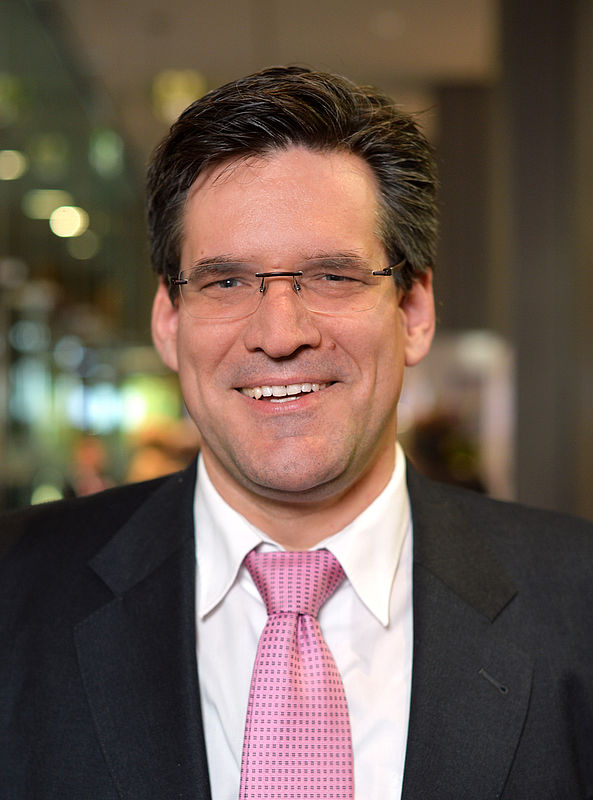TAVI is a minimally invasive technique used to replace the aortic valve, the heart valve between the left ventricle and the aorta. A catheter is inserted, usually through the groin, and the new, convoluted heart valve is placed on the tip of the catheter. Once inside the heart, the replacement valve is expanded and put into place. TAVI has so far been used mainly in older, very sick patients [1]. In these patients, the risk of dying during surgical aortic valve replacement (SAVR) is too high. During this operation, the chest is opened and a heart-lung machine is attached. The aim of GARY is to clarify for other patient groups whether TAVI or surgical valve replacement is better for them and to develop clear decision-making criteria. To this end, the registry collects treatment data from aortic valve procedures throughout Germany and evaluates it. Around 64 hospitals are currently participating in GARY.
"Statistically evaluating the data collected in the registry is complex. This is because the patient groups we are comparing are very different," explains Professor Eva Herrmann, Director of the Institute for Biostatistics and Mathematical Modeling at Goethe University Frankfurt. She leads the special evaluations funded by the DZHK. For example, patients who receive TAVI are on average 80 years old and very ill. In contrast, patients who have the heart valve implanted with surgery are about 69 years old and do not have as many underlying diseases. These differences must be adequately accounted for in statistical data analysis. Therefore, not all evaluations can be funded through the registry.
The special GARY evaluations funded by the DZHK focus on patients undergoing dialysis dialysis, with renal insufficiency, varying degrees of severity of aortic valve stenosis, or those who are severely underweight, but also the comparison of different replacement valves and patients with pacemakers.
Criteria for selection of the treatment method
The European guidelines for the treatment of valvular heart disease provide a risk classification for deciding when surgical valve replacement is needed. However, parameters that are not included in these conventional risk scores should be considered.
These include body weight, calculated by the body mass index (BMI). Compared with patients within normal weight range (BMI 20-30 kg/m2), underweight patients (<20 kg/m2) have higher mortality rates with both treatment strategies [2]. Recently published GARY special evaluations conclude that underweight patients with BMI <20kg/m2 benefitted equally from both treatment methods. Results show that TAVI and SAVR patients have similar survival rates at one and 12 months post-treatment. However, severely underweight patients (BMI of < 18.5kg/m2) had higher survival with TAVI.
Another analysis of registry data funded by the DZHK showed that the severity of chronic kidney disease influences whether patients undergoing TAVI or SAVR die [3]. Therefore, in patients with chronic kidney disease and a severely narrowed aortic valve, a measure based on certain laboratory values called the glomerular filtration rate (GFR) value can help estimate which patients are candidates for valve replacement. The value indicates how effectively the kidneys clean the blood and, in addition to the protein content, is used to assess the severity of chronic kidney disease.
Chronic dialysis patients with aortic valve stenosis who underwent TAVI or SAVR had the same 1-year mortality rate, although survival at 30 days was better with surgery using TAVI [4]. SAVR patients required more blood transfusions and had a longer hospital stay. In contrast, TAVI patients more often required pacemaker implantation and had a leaky aortic valve (aortic regurgitation).
This conclusion was also reached in another study in which patients who received a pacemaker after SAVR or TAVI treatment were investigated [5]. Significantly more pacemakers were implanted after TAVI compared with SAVR. After 30 days, the mortality rate did not differ between TAVI and SAVR. Accordingly, pacemaker implantation does not increase the risk of death.
Largest long-term evaluation to date
GARY enabled the largest dataset to date, 18,010 TAVI and SAVR patients who received a new heart valve in 2011 and 2012, to be analysed for survival after 5 years [6]. TAVI patients were significantly older and had a higher risk score than SAVR patients. Nevertheless, to compare long-term outcomes, the investigators paired data from TAVI and SAVR patients with equal risk scores. This showed a higher mortality rate after five years in TAVI patients with first-generation replacement valves than in SAVR patients. The authors noted that since 2011, implanted valves have steadily improved, as have clinical capabilities. This may be one reason why the data are not comparable with today's situation and differ from the results of more recent studies.
Comprehensive documentation
Since 2011, the German Aortic Valve Registry has been collecting data on the medical procedure of heart valve replacement. Symptoms, accompanying diseases, information on the state of health, the indication and the exact course before, during and after the procedure are all documented. The registry is a joint project of the German Society for Thoracic and Cardiovascular Surgery (DGTHG) and the German Society for Cardiology - Cardiovascular Research (DGK), sponsored by the German Heart Foundation.
More information about GARY:
https://www.aortenklappenregister.de
Contact: Christine Vollgraf, Press and public relations , German Centre for Cardiovascular Research (DZHK), Tel.: +49 (0) 30 3465 529 02, presse(at)dzhk.de
References
1. Bekeredjian R, Szabo G, Balaban Ü, et al (2019) Patients at low surgical risk as defined by the Society of Thoracic Surgeons Score undergoing isolated interventional or surgical aortic valve implantation: In-hospital data and 1-year results from the German Aortic Valve Registry (GARY). Eur Heart J 40:1323–1330. doi.org/10.1093/eurheartj/ehy699
2. Voigtländer L, Twerenbold R, Schäfer U, et al (2020) Prognostic Impact of Underweight (Body Mass Index <20 kg/m2) in Patients With Severe Aortic Valve Stenosis Undergoing Transcatheter Aortic Valve Implantation or Surgical Aortic Valve Replacement (from the German Aortic Valve Registry [GARY]). Am J Cardiol 129:79–86. doi.org/10.1016/j.amjcard.2020.05.002
3. Mas-Peiro S, Faerber G, Bon D, et al (2021) Impact of chronic kidney disease in 29 893 patients undergoing transcatheter or surgical aortic valve replacement from the German Aortic Valve Registry. Eur J Cardiothorac Surg 59:532–544. doi.org/10.1093/ejcts/ezaa446
4. Färber G, Bleiziffer S, Doenst T, et al (2021) Transcatheter or surgical aortic valve implantation in chronic dialysis patients: a German Aortic Valve Registry analysis. Clin Res Cardiol 110:357–367. doi.org/10.1007/s00392-020-01717-7
5. Fujita B, Schmidt T, Bleiziffer S, et al (2020) Impact of new pacemaker implantation following surgical and transcatheter aortic valve replacement on 1-year outcome. Eur J Cardio-thoracic Surg 57:151–159. doi.org/10.1093/ejcts/ezz168
6. Beyersdorf F, Bauer T, Freemantle N, et al (2021) Five-year outcome in 18 010 patients from the German Aortic Valve Registry. Eur J Cardio-Thoracic Surg 60:1139–1146. doi.org/10.1093/ejcts/ezab216


